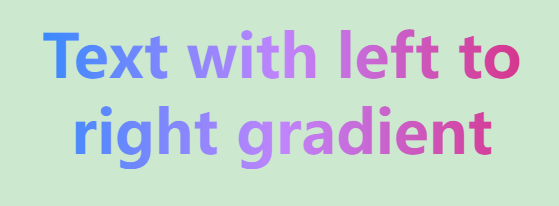太酷了!用 CSS 让背景渐变动起来!
在这个小技巧中,我们将展示如何用 CSS 轻松地让背景渐变动起来。
在最近的一篇文章中,我们展示了 如何在文本上设置背景渐变。下面的 CodePen 演示展示了结果。

h1 {
color: transparent;
-webkit-background-clip: text; /* Edge, Chrome */
background-clip: text; /* Safari, FF */
background-image: linear-gradient(
to right,
#218bff,
#c084fc,
#db2777
);
}
如果你不确定我们是如何得到这个结果的,请务必阅读那篇文章,因为我们将在下面的例子中以此为基础。
为了演示,让我们在渐变背景中添加一些额外的颜色:
h1 {
background-image: linear-gradient(
45deg,
#ffb3ba,
#c49c6e,
#bfbf76,
#77b084,
#ff7e74,
#3b82f6,
#c084fc,
#db2777
);
}
如果我们暂时关闭 background-clip: text 和 text-color: transparent,我们可以更好地了解渐变是如何填充文本内容框的。

现在让我们来看看如何让背景渐变动起来。
第 1 步:调整背景大小
要让渐变背景动起来,我们需要让它比文本内容框大,这样我们就不能一次看到它的全部。我们可以使用方便的 background-size 属性来做到这一点。
我将把渐变背景的宽度设置为标题元素宽度的三倍:
h1 {
background-size: 300% 100%;
}
现在,任何时候都只能看到三分之一的渐变背景,如下所示。

第 2 步:设置动画
接下来,我们将设置一个动画,使背景移动,这样我们就能随着时间的推移看到不同的部分。
我们可以像这样设置一个简单的动画规则:
h1 {
animation: gradientAnimation 8s linear infinite;
}
这将使背景每 16 秒来回移动一次。
接下来,我们将设置一个 @keyframes 语句:
@keyframes gradientAnimation {
0% {
background-position: 0;
}
to {
background-position: 100%;
}
}
这个简单的 @keyframes 语句将使我们的背景每 8 秒从左上角移动到右下角。
在下面的 Pen 中,我们再次禁用了 background-clip: text 和 color: transparent,这样我们就可以看到背景中发生的事情。

h1 {
background-image: linear-gradient(45deg, #ffb3ba, #c49c6e, #bfbf76, #77b084, #ff7e74, #3b82f6, #c084fc, #db2777);
/*color: transparent;*/
/*-webkit-background-clip: text;*/ /* Edge, Chrome */
/*background-clip: text;*/ /* Safari, FF */
animation: gradientAnimation 8s linear infinite;
animation-direction: alternate;
background-size: 300% 100%;
}
@keyframes gradientAnimation {
0% {
background-position: 0;
}
to {
background-position: 100%;
}
}
一旦我们重新启用 background-clip: text 和 color: transparent,我们就会看到最终的效果。

h1 {
background-image: linear-gradient(45deg, #ffb3ba, #c49c6e, #bfbf76, #77b084, #ff7e74, #3b82f6, #c084fc, #db2777);
color: transparent;
-webkit-background-clip: text; /* Edge, Chrome */
background-clip: text; /* Safari, FF */
animation: gradientAnimation 8s linear infinite;
animation-direction: alternate;
background-size: 300% 100%;
}
@keyframes gradientAnimation {
0% {
background-position: 0;
}
to {
background-position: 100%;
}
}
很酷吧!
让背景图片动起来
在我们关于为文本添加渐变效果和图案的文章中,我们还使用了一个花卉背景图片。
我们也来尝试让这个背景动起来。我们将以稍微不同的方式进行操作,因为我们不想扭曲背景图片。
让我们从原始演示中删除 background-size: contain,并且根本不设置背景大小。这给我们留下了这样的代码:
h1 {
color: transparent;
-webkit-background-clip: text; /* Edge, Chrome */
background-clip: text; /* Safari, FF */
background-image: url(floral.jpg);
-webkit-text-stroke: 1px #7512d7;
text-stroke: 1px #7512d7;
animation: gradientAnimation 20s linear infinite;
animation-direction: alternate;
}
@keyframes gradientAnimation {
0% {
background-position: 0;
}
to {
background-position: 100%;
}
}
结果如下面的 CodePen 演示所示。

如果你想看看背景中发生了什么,请尝试暂时关闭 background-clip: text 和 text-color: transparent。
我们的背景图片默认情况下是重复的,对于这张特定的图片来说,看起来还不错。(出于好奇,你可以尝试添加 background-repeat: no-repeat 来看看在没有重复背景的情况下会发生什么。)在其他情况下,如果背景图片平铺效果不好,你可能想要防止图片重复,然后使用 background-size 来放大图片,就像我们上面对渐变背景所做的那样。例如:
h1 {
background-repeat: no-repeat;
background-size: 120%;
}
以下是将这种方法应用到我们的花卉演示中的效果。

h1 {
color: transparent;
-webkit-background-clip: text; /* Edge, Chrome */
background-clip: text; /* Safari, FF */
background-image:
url(https://uploads.sitepoint.com/wp-content/uploads/2024/03/1710934391floral.jpg);
background-repeat: no-repeat;
background-size: 120%;
-webkit-text-stroke: 1px #7512d7;
text-stroke: 1px #7512d7;
animation: gradientAnimation 30s linear infinite;
animation-direction: alternate;
}
@keyframes gradientAnimation {
0% {
background-position: 0;
}
to {
background-position: 100%;
}
}
总结
我们可以做比这更壮观的动画,但我们的目标是保持简单。你也可以尝试调整动画的时间、渐变的角度等等。
正如上一篇文章中提到的,尽情发挥你的创意,但不要过度使用,因为太多的这种动画会让人厌烦。在标题上添加一个微妙的动画背景,可能会增加一些趣味或吸引力,让你的读者保持兴趣。
